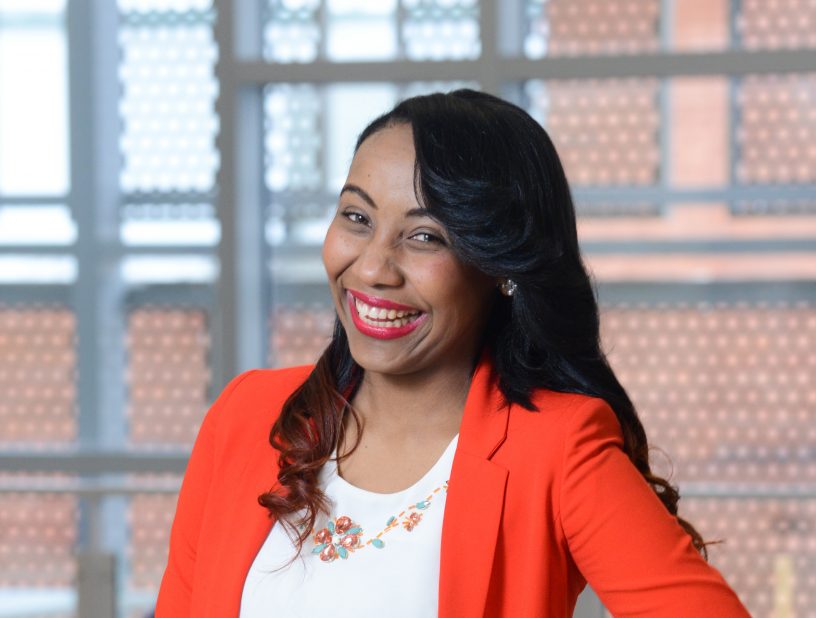It’s been a Diplomatic week at Northern Essex Community College.
Diploma Diplomacy
Jessica Castillo was eighteen years old when she arrived in Lawrence from the Dominican Republic in 2007.
She spoke no English, and worked three jobs, seven days a week, while enrolled in the English-as-a-Second Language (ESL) program at Northern Essex Community College.
A few semesters—and an expanded vocabulary—later, she enrolled in NECC’s iHealth Healthcare Practice Management Program, while working her way up from child care, to the front desk, to office manager at the Lawrence Dental Center.
When she graduated with her Associate Degree last year, she enrolled in an online program at St. Joseph’s College in Maine that accepts up to three years of credits from NECC—so she only had to take her senior year to complete her Bachelor’s degree in Business Management.
Jessica is a real success story.
But for every student like Jessica who overcomes the odds and makes it, many more in and around Lawrence still do not.
While the rest of Massachusetts enjoys the reputation as the most educated state in the nation (more than 40% of adults in the Commonwealth have at least a bachelor’s degree), the residents of Lawrence lag far behind. According to the United States Census Bureau’s American Community Survey for 2014, only 12% of the adults aged 25 and over in Lawrence have a bachelor’s degree or higher.
This is a serious educational, economic, and workforce development challenge.
And opportunity.
In a city of nearly 80,000 residents, where 74% of the population is Hispanic—mostly from the Dominican Republic and Puerto Rico—and faces daily challenges with language, employment, education, poverty, and a host of other barriers, more young people than ever before are finding their way into college.
Three years ago, in 2013, 69% of Hispanic high school graduates went to college in the United States, passing the rate of white high school graduates going to college (67%) for the first time.
The same thing is happening in Lawrence.
Over the last five years, the number of students graduating from Lawrence High School and enrolling at NECC in the fall has doubled; and, despite recent enrollment declines at community colleges across the country, NECC’s Lawrence campus is holding steady at over 3,000 students—an increase of nearly 30% over the last ten years. Over 60% of those students, about 2,000 altogether, are Hispanic, mostly from the Dominican Republic.
These are encouraging signs, indeed.
And yet…
Despite some important gains in “closing the gaps” between minority and majority student success over the last ten years through NECC’s work in Achieving the Dream, Title V, and other initiatives, the retention, completion, and graduation rates of our Hispanic students remain lower than they should be.
These students face extra challenges while pursuing their education. The English language remains a significant barrier for many. Even those been born in the U.S. may have been raised in households where Spanish is the primary language spoken, and as a result, they may not be completely fluent in either language.
Many of them are the first in their families to attend college, which often means they struggle financially, may not have the same supports as other students, and frequently have family responsibilities that conflict with academic responsibilities.
And to further complicate their pursuit of a college degree, many residents of Lawrence with roots in the Dominican Republic find themselves traveling back and forth frequently in support of family needs.
Then there are the residents of Lawrence (and other communities in the state) who may have completed classes or entire degrees at colleges in other countries, like the Dominican Republic; but those degrees have not been validated in the United States and are not recognized by employers here.
As a result, some immigrant professionals, including teachers, doctors, dentists, and engineers, may find themselves working in much lower-paying service industry jobs as waitresses, janitors, and cab drivers.
For all these reasons and many more, last week I traveled to the Dominican Republic with a delegation of educators and elected officials, including NECC’s Executive Director of Lawrence Campus and Community Relations, Dr. Noemi Custodia-Lora, Lawrence Mayor Daniel Rivera, and Massachusetts State Representative Marcos Devers.
Our goal?
To create as many opportunities as possible for students in either Massachusetts or the Dominican Republic to complete their education at NECC or a Dominican college or university.
If we are successful, many people will benefit from more education, a better prepared workforce, and higher standards of living in what today are impoverished and disadvantaged communities—in both countries.
While poor by U.S. standards, the Dominican Republic is the largest economy in the Caribbean and Central American region, and over the last twenty years, the nation has been moving from agriculture and mining toward telecommunications and a booming service industry.
One sure sign of an emerging modern economy in this nation of 10 million people is an increased focus on the importance of education at every level.
Long suffering from one of the worst education systems in the region, the voters of the Dominican Republic convinced their candidates for president in 2012 to promise, if elected, to double the education budget for primary and secondary grades.
President Danilo Medino is following through on his campaign pledge, and has doubled spending on education from 2% to 4% of the DR’s Gross Domestic Product. In dollar terms, that’s a big boost, from $1 billion to just over $2 billion last year.
At the same time, the Dominican Republic has been investing in higher education, and seeing some significant progress.
The nation is home to the oldest university in the western hemisphere. The Universidad Autónoma de Santo Domingo was founded by a papal decree of Pope Paul III in 1538.
In 1960, more than 400 years later, it was still the only university operating in the country, and it enrolled 3,700 students.
Now, just fifty years later, there are 46 colleges and universities enrolling nearly 400,000 students, and the government has set a target of increasing participation in higher education to 50 percent of the college age population—about 660,000 students—by 2018.
Even as more students are finding their way onto campuses in the DR, the number of Dominican students travelling internationally for higher education has also increased by more than 50% over the last eight years. Now, nearly 4,000 students from the DR study abroad each year—mostly in the United States and Spain, and often on government-funded scholarship programs.
Under a new 10-year plan for higher education in the Dominican Republic, 10,000 international scholarships—across all levels—will be awarded for study at foreign universities in key areas for national development and competitiveness.
And get this: That plan also calls for the creation of something brand new to the island nation—community colleges.
Our visit last week included a tour and a partnership agreement signing ceremony with the Instituto Técnico Superior Comunitario (ITSC), also known as San Luis Community College, the first community college in the country, which opened its doors in 2012, already enrolls 3,700 students, and just bestowed degrees on their first class of 115 graduates.

According to Victor Hugo De Láncer, the founding Rector (president) of ITSC, it was the largest infrastructure investment the country had made since the creation of the Santo Domingo Metro System, which just began running public transit trains in 2009.
The 200,000 square foot ITSC campus (about half the size of NECC’s Haverhill campus) includes 13 buildings of classrooms, laboratories, offices, an auditorium, library, and other spaces built at a cost of $1.8 billion Dominican Pesos, about $38 million—and it is already making a tremendous difference in San Luis, where small shops and new houses are being built nearby, in neighborhoods once entirely filled with shacks, abandoned bodegas, and rubble.
An hour or so north of San Luis, in the poor, rural province of Monte Plata, we met with a group of local residents, elected officials, and educators who are eager to launch the country’s second community college—and hopeful that NECC might work with them as a “big brother” in their effort.

Their province may not have much. Farming and some tourism are the dominant industries, and motorcycles, bicycles, and burros far outnumber cars on the rough roads; but, like most communities in the DR, they have a place to play baseball, and this citizens committee is excited about the idea of building a community college, along with an elementary school, a high school, and dormitories around their prized athletic complex in what they dream will become a “City of Knowledge” for generations to come.

The final stop on our visit was the Universidad Autónoma de Santo Domingo, affectionately known to the nearly 200,000 students across the country as UASD (pronounced “Wazzed”).
Many Dominicans in the United States, including our very own State Representative Marcos Devers, are graduates of UASD, and a lot of NECC students arrive with credits from one of the university’s 18 campuses.
Last August, Dr. Clara Benedicto, UASD Director of International Relations, visited NECC’s Lawrence campus and took part in a historic signing ceremony between our two institutions.
On this trip to the DR, we completed our pact. In front of a packed room of UASD faculty and staff, and a large group of newspaper and television reporters, Dr. Custodia-Lora and I, along with UASD Rector Iván Grullón and Lawrence Mayor Daniel Rivera, presented remarks and signed an agreement pledging to work together to expand and improve educational opportunities for all of our students and the communities we serve.

In the months and years ahead, our hope is that these new partnerships will lead to faculty and staff cultural exchanges, simpler transfer of credits between colleges and universities, improved English-as-a-Second Language opportunities for Dominican immigrants in and around Lawrence, a simplified process for verifying college degrees from other countries, and expanded online enrollment in NECC courses—all of which can go a long way toward increasing the number of adults in Lawrence with a college degree and making the city more competitive in the regional economy.
And maybe, just maybe, in a true demonstration of international cooperation and the value of academics and student engagement…
Spring training and an exhibition game between the NJCAA World Series contender Northern Essex Community College Knights and the Liga de Beisbol UASD Resinto Santiago.
Let’s play ball!
Hip-Hop Hamilton
Speaking of immigrants from the Caribbean…
The hottest ticket on Broadway right now is for Hamilton, the hip-hop musical about the Revolution and America’s Founding Fathers from author and composer Lin-Manuel Miranda.
Featuring a youthful, multi-racial cast (George Washington is played by the 6’2” African American Christopher Jackson, freestyle rapper Daveed Diggs is Thomas Jefferson, and the 36-year-old Puerto Rican Lin-Manuel Miranda himself is Hamilton), and a catchy blend of rap, pop, hip-hop, rock, and 42nd Street show tunes, Hamilton is the story of how one of America’s most famous immigrants (Alexander Hamilton was born in 1755 on the island of Nevis in the British West Indies, just a few hundred miles east of Santo Domingo in the Dominican Republic) grew up to help win the Revolution, create the Constitution, become the country’s first Secretary of the Treasury, and lose his life in a pistol duel with Vice President Aaron Burr.
The show is sold out for the rest of the year, and resale tickets cost anywhere from $500-$1,000 (with a few bargain seats available next October for under $300 a cushion).
But $19.99 will get you all 46 numbers of the show’s speaker-thumping soundtrack on iTunes, and around my house, Big Sis T and Little Sis Z have been playing it “Non-Stop” (Hamilton fans will get the reference) for the last couple of months.
The experience can be a little jarring at first, but you get used to it quickly.
One of the numbers is a “Cabinet Battle” featuring rap-style word combat about Hamilton’s plan for the federal government to assume state debts and establish a national bank.
Not exactly the kind of material that you would expect Alan Greenspan to break into song about, but in the world ofHamilton Thomas Jefferson gets to rap:
“Life, liberty and the pursuit of happiness”
We fought for these ideals; we shouldn’t settle for less
These are wise words enterprising men quote ‘em
Don’t act surprised, you guys, cuz I wrote ‘em
But Hamilton forgets
His plan would have the government assume state’s debts
Now, place your bets as to who that benefits
The very seat of government where Hamilton sits
Oooh! That’s a stinger.
Big Sis T and Little Sis Z’s favorite numbers are “The Schuyler Sisters” (a pre-Feminist ode to women’s rights in which Angelica Schuyler vows to get Jefferson to “include women in the sequel” to the Declaration of Independence); “You’ll Be Back” (in which a boyish King George taunts the colonists about their tea-tossing tantrum); and “The Ten Duel Commandments” (which explains the rules for dueling in the first act, and foreshadows the deaths of Hamilton and his son, Philip, in act two).
American history has rarely seemed so hip and popular, but it may be time to give it a rest for a while.
A few days ago, Big Sis T came down to breakfast still looking very tired, and not quite ready to face her day. I asked her what was wrong, and she explained that she had a terrible night’s sleep.
“What was wrong?” I asked.
“All night long I was tossing and turning,” she explained, “dreaming that I was John Adams, destroying the Federalist Party and ruining the reputation of Alexander Hamilton.”
“Really?” I asked, “Most kids your age have dreams about being rock stars, or nightmares about showing up for a test you haven’t studied for. You’re dreaming about being a 65-year-old colonial Founding Father?”
“It could be worse, Dad,” she offered, “At least I wasn’t dreaming that I was Aaron Burr.”
“Good point. Have an English muffin,” I suggested, “You’ll feel better.”
As you look back on your week, and forward to the one ahead, may you reach out across a border, take a lesson from your nation’s past, and rap to your own beat.
And if you’d like to learn more about what’s been happening at NECC, please:
Visit the NECC Newsroom
Find me at www.facebook.com/lane.a.glenn
Or on LinkedIn
–Lane






